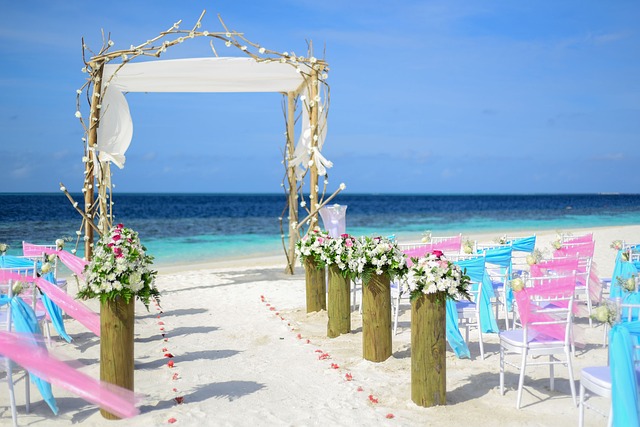ENTERTAINMENT
Importance of a good florist for a wedding


There are so many details to consider, including the wedding reception flowers, which are one of the most significant. Flowers bring a sense of color and emotion to your wedding. It’s crucial to make the appropriate decision and compliment your wedding theme. There are many flower arrangements for each wedding type: romantic, rustic, elegant, vintage, industrial, or classic.
At a wedding, flowers are everywhere. From bouquets, boutonnieres to petals down the aisle and table centerpieces, there’s something for everyone. The wedding reception flowers, like the bride’s bridal gown, play a significant role in the overall ambiance of the wedding. There are no boundaries on what you can do with your floral arrangements. Flowers come in the variety of shapes, sizes, and colors and are suitable for both modest and luxurious weddings. You need a find the best florist because it is essential. Finding a florist for wedding flower bouquets and arrangements is not an easy job to do, but it is definitely worth it.
Know the difference between a florist and a floral designer.
Strong notes, “A floral designer will be curating a design and knows how to work with a vendor team.” A florist, on other hand, is more likely to work out of a physical location selling a la carte arrangements. A florist will suffice if you only require a few modest items that can be picked up ahead of time (for example, bouquets, boutonnieres, and a small number of table arrangements). However, if you need help activating a room or bringing a concept to life, and you want to include larger components that need to be erected on-site, such as floral arches or floral chandeliers.
They match your aesthetics:
Floral designers are, at their core, artists. They went into the company because they enjoy creating beautiful objects, yet beauty implies different things to different people. So, when it comes to choosing the vendor, don’t try to squeeze a round peg into a square hole for the greatest outcomes. Don’t select someone with a portfolio full of strict, orthodox styles if you prefer ethereal, loosely constructed designs. The “compromise” you’ll reach while trying to meet halfway will almost certainly disappoint both parties—and that’s the last thing anyone wants on the wedding day.
Don’t rely only on social media for your needs.
It’s important to explore a little deeper once you’ve identified a floral designer whose style you like. While an Instagram grid is a good place to start, it’s typically dominated by self-selected moments of a designer’s best work and outtakes from styled shots, which don’t always reflect what can be done on a budget.
Strong recommends moving to a vendor’s “tagged” photographs for a fast look at a less curated version of their work to obtain a more multi-dimensional sense of them. The next step is to look through complete galleries of weddings they’ve done. If you fall in love with the vendor’s bouquet, this will give you an idea of how their aesthetic will translate to other aspects of the event. It will also assist you in determining what they are capable of producing at various budget levels.
Let’s talk about money.
When it comes to money, pricing compatibility is a critical factor to consider when selecting a flower provider. Floral service prices vary widely and can skyrocket depending on a variety of criteria such as the number of guests, flower preferences and seasonality, and design choices. All of this is to suggest that it’s nearly impossible for a designer to set a fixed price for their services, which is why you rarely see them advertised publicly. Start with ten percent of your whole budget to get a sense of where you might end up.
More questions should be asked.
Aside from the budget, there are a few logistical issues to resolve. How many weddings does the vendor attend over the weekend? Will they be physically there to supervise your event setup, or will they delegate this responsibility to another member of their team? Who will be in charge of cleanup? “A skilled designer will offer you those answers ahead of time,” says Strong, who adds that this is also the time to enquire about communication preferences and the level of control you have over the final vision.
Take a look at their feedback.
However, use them as a guideline rather than a deciding factor. “I believe reviews are an additional tool, but not the only one,” says Strong. “They aren’t always an accurate or even fair evaluation of someone’s work.” If a vendor’s ratings are primarily bad, that’s a good reason to avoid them, but what if there are one or two unhappy customers among a sea of positive appraisals? Strong’s advice: Inquire directly with the vendor about what transpired in those instances. “They won’t have a difficulty explaining themselves if they’re in the right,” he says. “However, if they’re worried about it, it could be a red flag.”
Keep the concept of sustainability in mind.
Florals, along with food, are one of the most waste-prone aspects of a wedding day. If reducing your environmental effect is a primary issue, there are a few other factors to consider when choosing a florist. If that isn’t possible, look for someone that works mostly with locally grown blooms. If that isn’t an option, there are techniques to reduce further energy consumption. Strong advises, “Ask how they dispose of their blossoms” (composting is ideal) and “what materials they utilize while designing.”
Conclusion:
The wedding flowers are the most significant part of the bride, aside from the groom and the gown! Flowers are the only decoration that says “wedding” more than anything else! They can be found in the bouquets and buttoners of the wedding party, as well as on the alter, or they can be found in a variety of places.
The motif of wedding flowers may be found in every décor, including the church, the road leading out of the church, the reception hall, and on every table in the dining room. However, if the bride is particularly particular about having only her favorite flower, this proposal appears to be quite costly!


